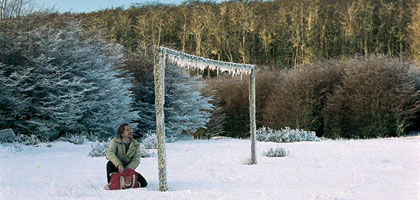The London Film Festival: Liverpool - A trilogy of closely observed characters

La libertad (2001), Los muertos (2004) and Liverpool (2008) constitute one of the most notable trilogies in contemporary film. Lisandro Alonso's remaining film, Fantasma (2006), works as a curious comment on the other three, starting with its title as, besides their furious nature, Alonso's films also share a ghostly quality. For a start, his work has hardly been seen. Defended only by a small bunch of film critics, confined to Cannes (more specifically, to the Quinzaine des Réalisateurs, where the most radical new generation - people like Albert Serra, Miguel Gomes or Raya Martín - take refuge) and to a few festivals around the world. Alonso's films perform even more negligibly at the box office in his native Argentina than in France.
There is an obvious unity to the trilogy and as with every great director, a question about the world becomes a question about the cinema. These films are at first a series of variations; studies of characters who are isolated from society and surrounded by nature. Misael Saavedra, the hero of La libertad, is a solitary woodcutter who works in the middle of the forest. He is a real person, but the film fictionalises 24 hours of his life, adding some imaginary events. The camera observes him as he cuts trees with incredible ability and a profound dedication to his task. Argentino Vargas of Los muertos, meanwhile, is not a killer, even if he has the same name as the protagonist he plays, a prisoner who takes a trip by river as the camera follows him, silently asking why he killed and if he will kill again. The two films share an obsession with observing human behaviour without giving any information beyond the character's actions. They both explore the limits of civilisation in order to question the last (or the first) element of humanity.
But Alonso is not an anthropologist with a camera. His is a film-maker's search, and his aim is more far-reaching than simply to record exotic behaviour in an extreme landscape. His films question the mystery of the observed, the place of the observer and the mechanism of cinema itself. That is exactly what Fantasma does, a very strange film in which Alonso takes the protagonists of his first two films, Misael and Argentino, thousands of kilometres away from their usual haunts to the San Martín Theatre in Buenos Aires, which functions as a cinemathèque. The film takes place in a rarefied atmosphere: the actors wander up and down the stairs, sit in a screening room, interact with people in the corridors and offices, but never fully participate in the cinematographic spectacle. The audience, the world, is always on the other side of the glass. The film provides catharsis for a film-maker who discovers that his vocation does not take him to a place of normality within the film universe, but to a precarious one similar to that experienced by his characters. Fantasma was filmed when Alonso could not get funding for Liverpool, a project that he had imagined as the natural continuation of his two earlier films.
At first glance, Liverpool differs little from La libertad and Los muertos. It is a powerful film with barely any dialogue, shot on 35mm. (As a militant devotee of the particular beauty and image quality that can be obtained only from film stock, Alonso rejects digital.) Farrel, the isolated and mysterious main character, is a sailor on board a ship sailing towards Ushuaia, the southernmost city in the world. On arrival, he asks permission from his captain to visit his mother - he does not know if she is still alive. He is a tormented soul, an unsociable alcoholic with an uncertain past who comes back, as Argentines often do, to what he left behind. In order to do this, he has to go deep into the inhospitable terrain of Tierra del Fuego to a sawmill in which the weather and the living conditions couldn't be any harder. There he finds three figures: his dying mother, who doesn't recognise him; a disabled adolescent who happens to be his daughter; and an old man who has taken care of the two women. After a few hours in this place, Farrel embarks on the return journey, leaving the story to carry on without him.
The camera's abandonment of the main character is the crucial difference between this and Alonso's two previous films. After Farrel's departure, the narrative carries on at the sawmill, following the everyday life of its inhabitants. Farrel abandons his family, but we could say that the film abandons him in turn. In some of the earlier shots the camera lingers in locations once Farrel has left them, as if prefiguring its later decision. This change in point of view is very noticeable in a minimalist film-maker like Alonso, who seems to walk the same path again and again, and it marks a point of inflection in his work. After obsessively following his characters through two films and doubting whether the function of the film-maker is to keep a distance from his characters' actions or to disclose their secrets, it's as if Alonso realises that the real question, morally speaking, is his role asa film-maker.
Alonso's attempt to reach the very limit of the civilised world takes him with Farrel to the brink of the wilderness but Farrel cannot stand it and runs away for the second time. In La libertad and Los muertos the camera stuck so closely to the protagonist as to be almost his reflection; here the camera and character separate abruptly. In this duality, Farrel takes the place of the film-maker, as if he knows that cinema has a frivolous relation to life, always trying to play safe and become part of the system like himself. The two old people and the young girl carry on living in their own world, one which is nevertheless real. The camera's decision to stay with them implies a commitment to the utopia of a real cinema, a cinema that is not afraid of its own discoveries.


